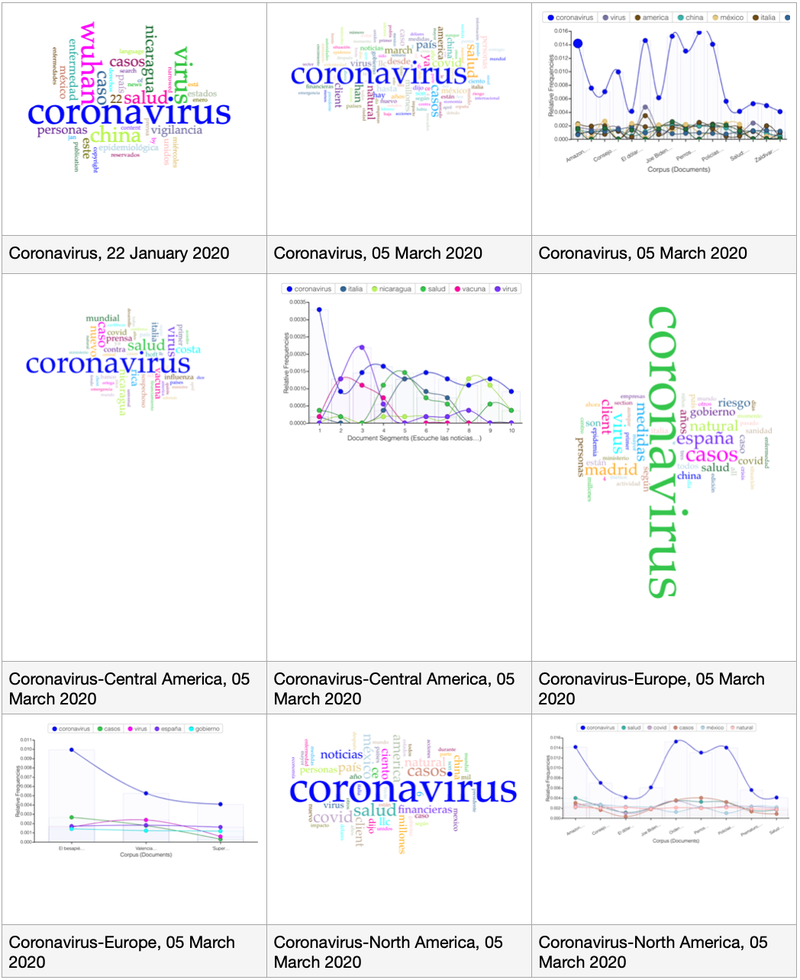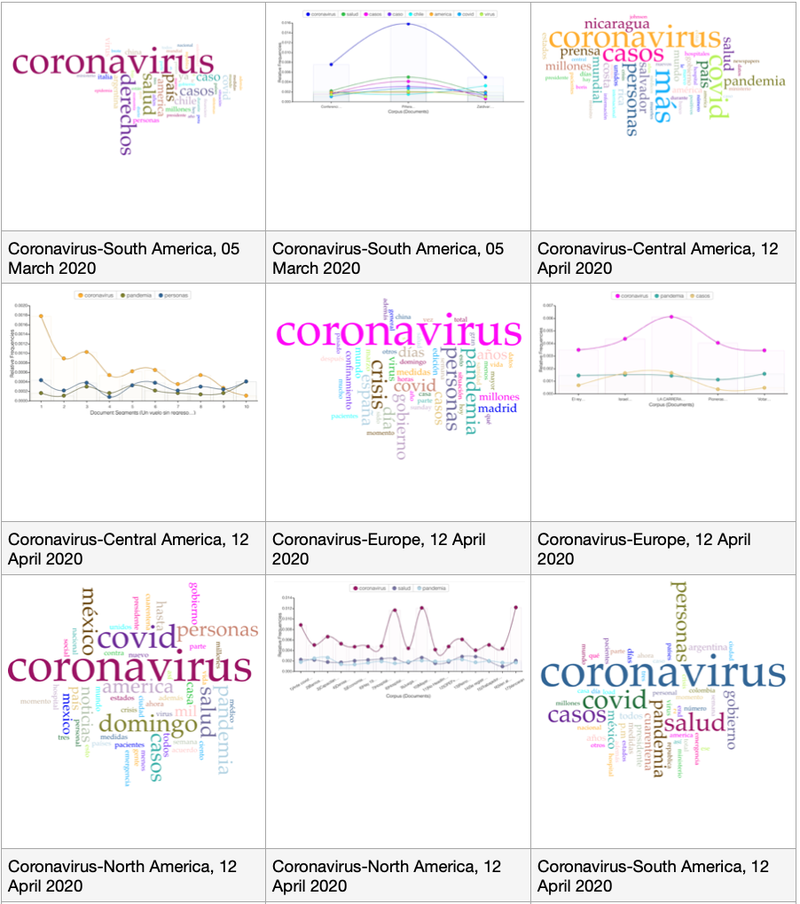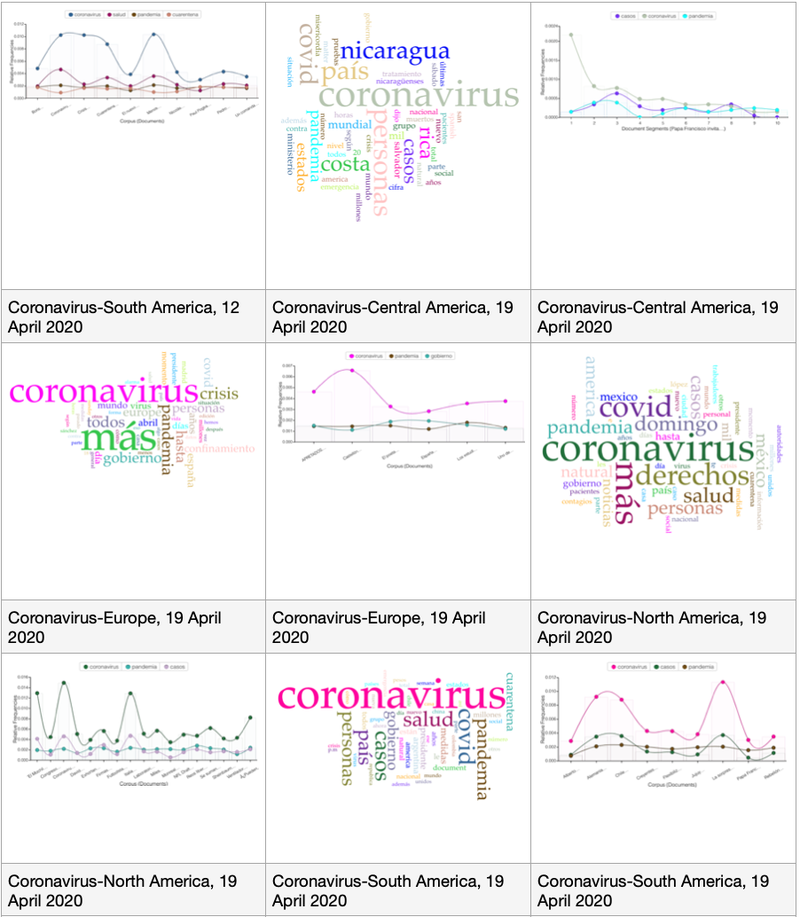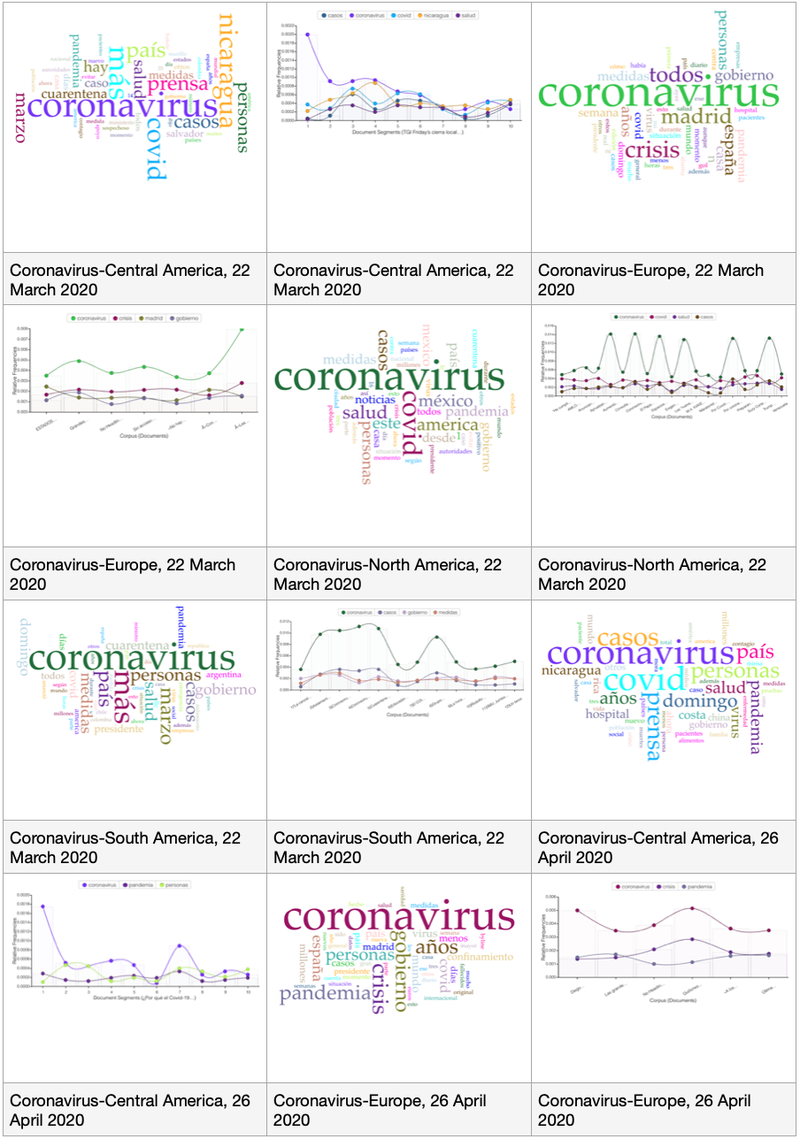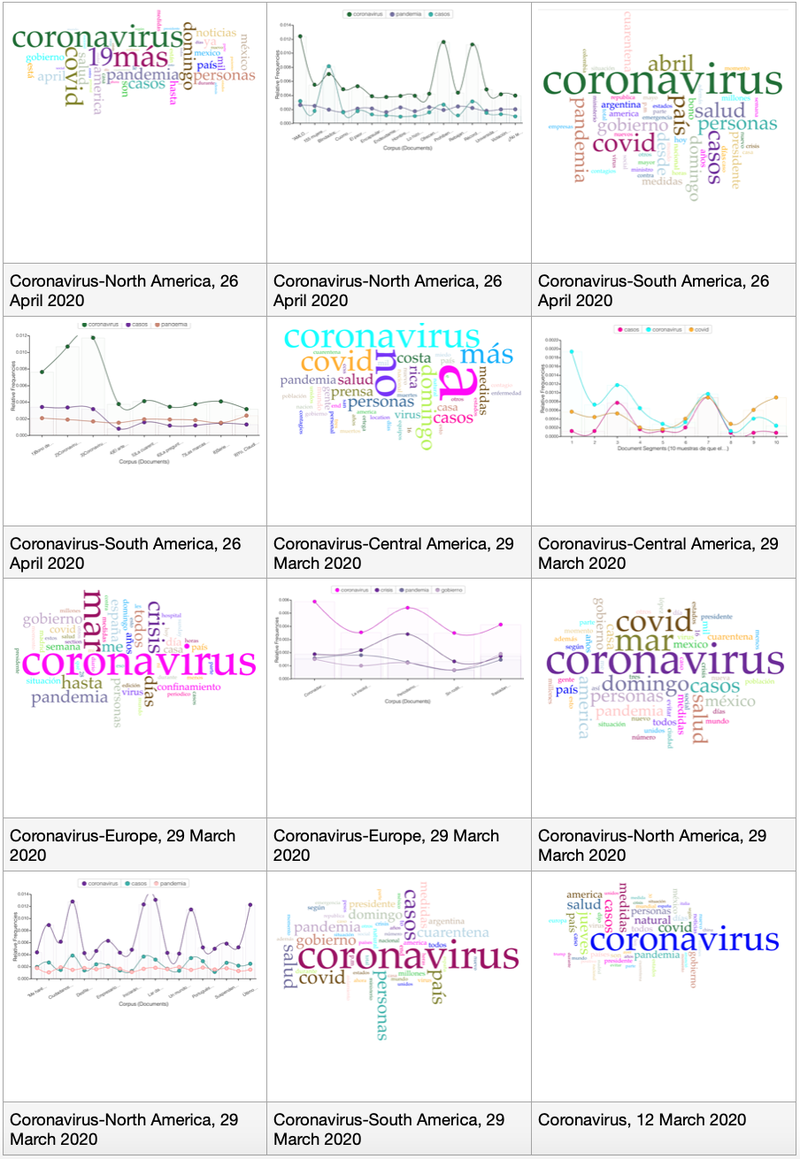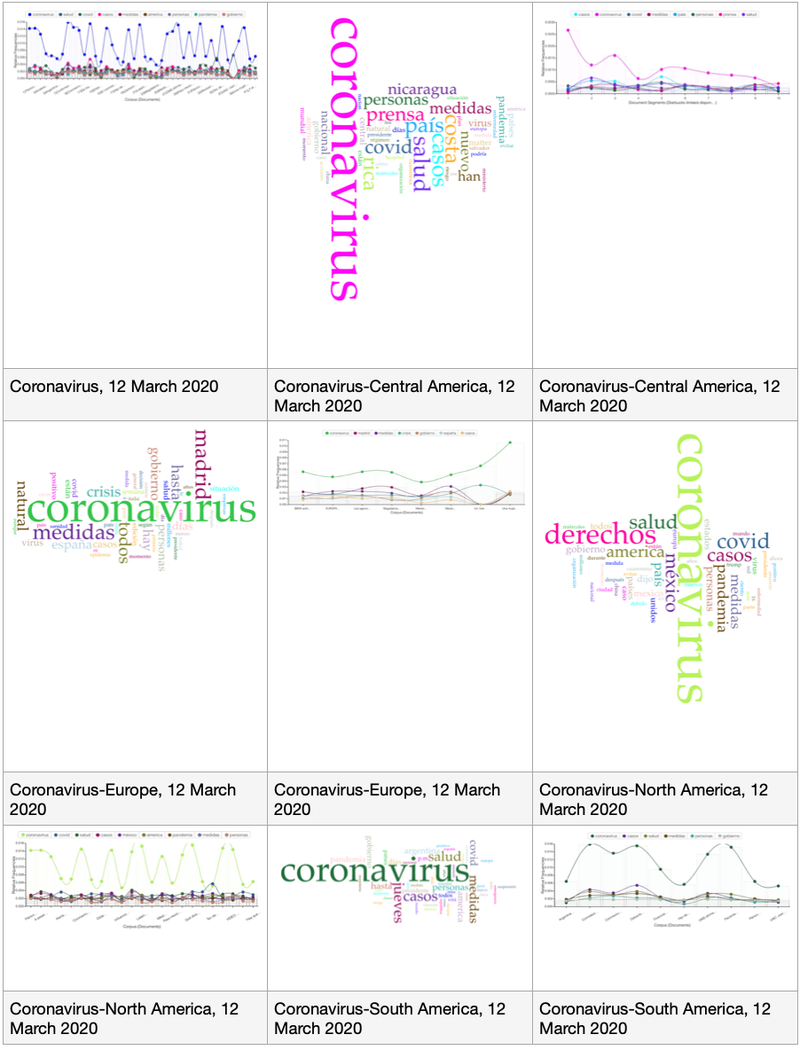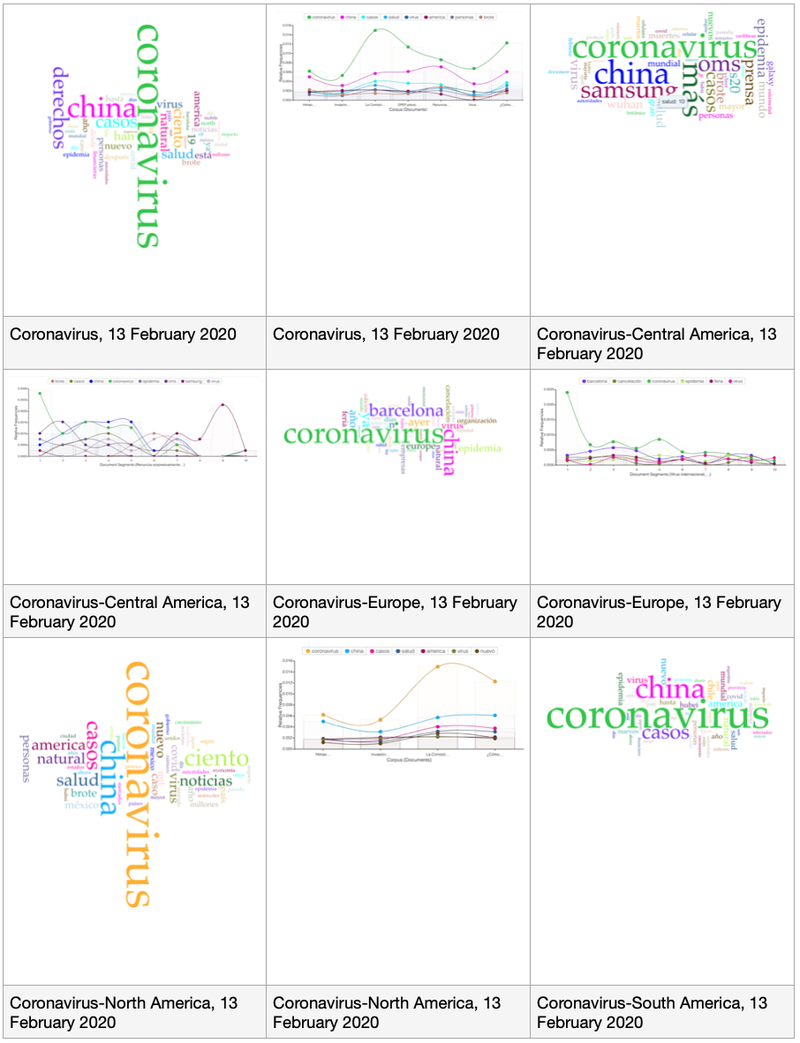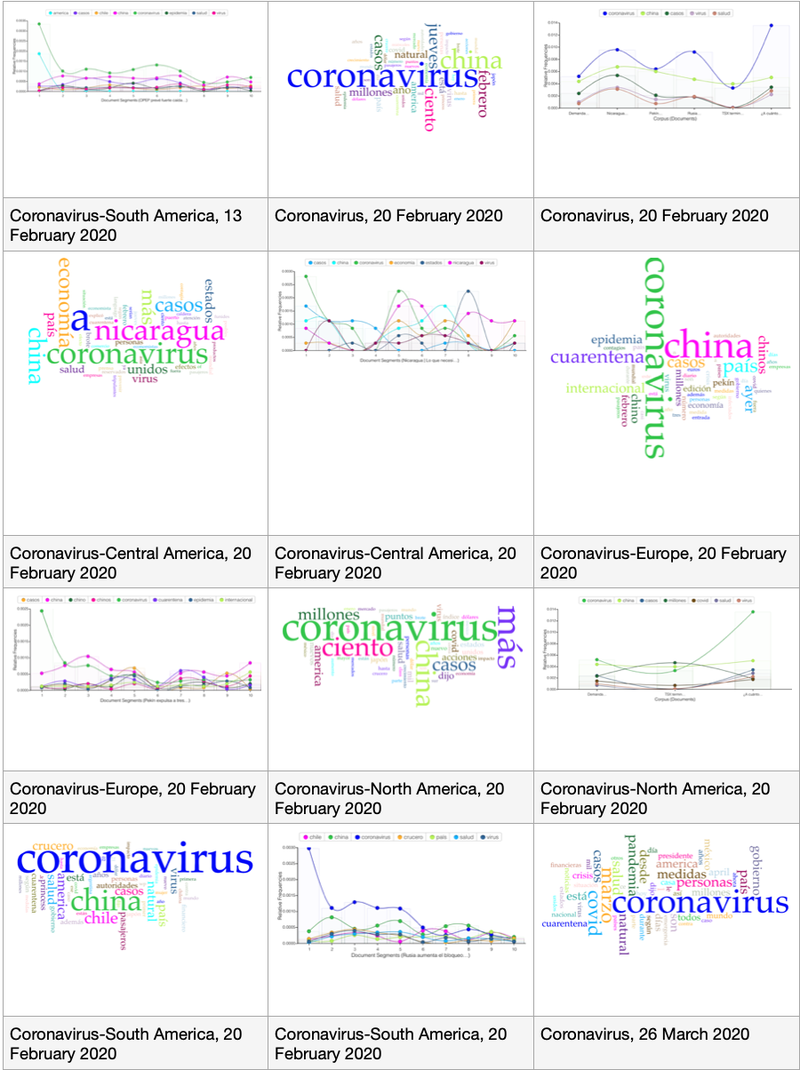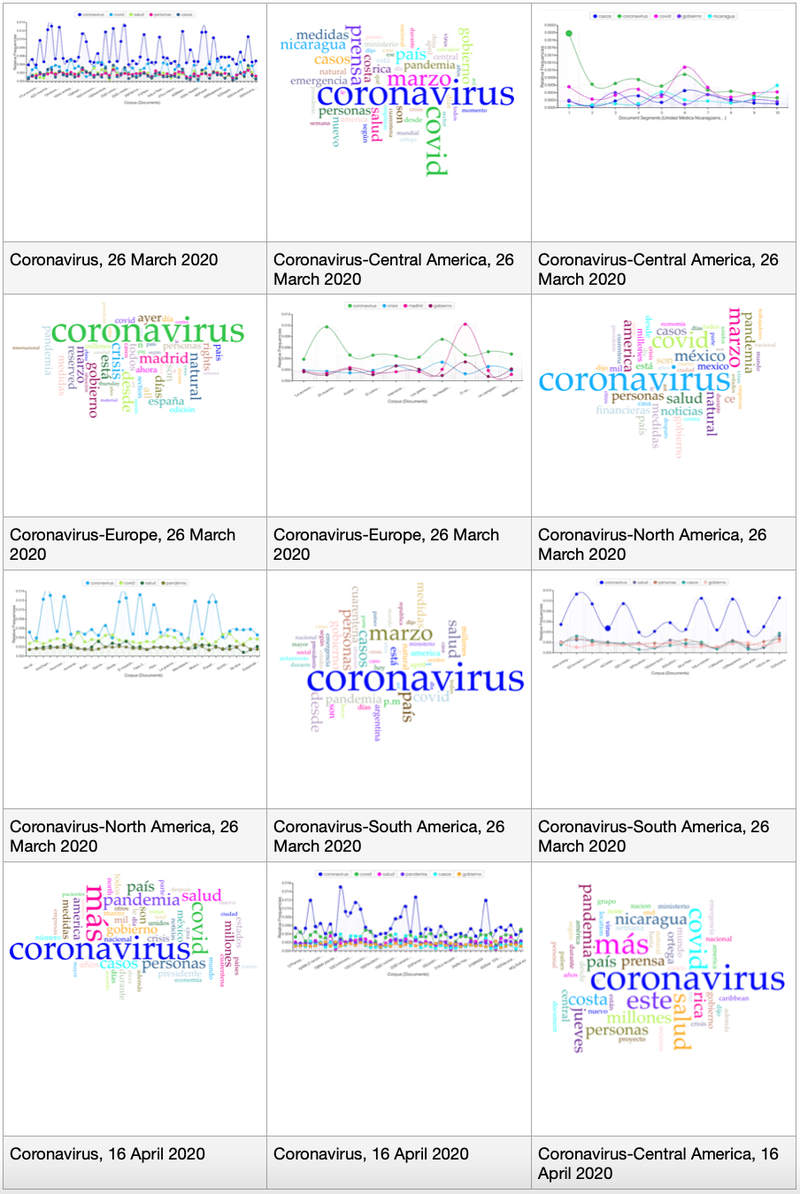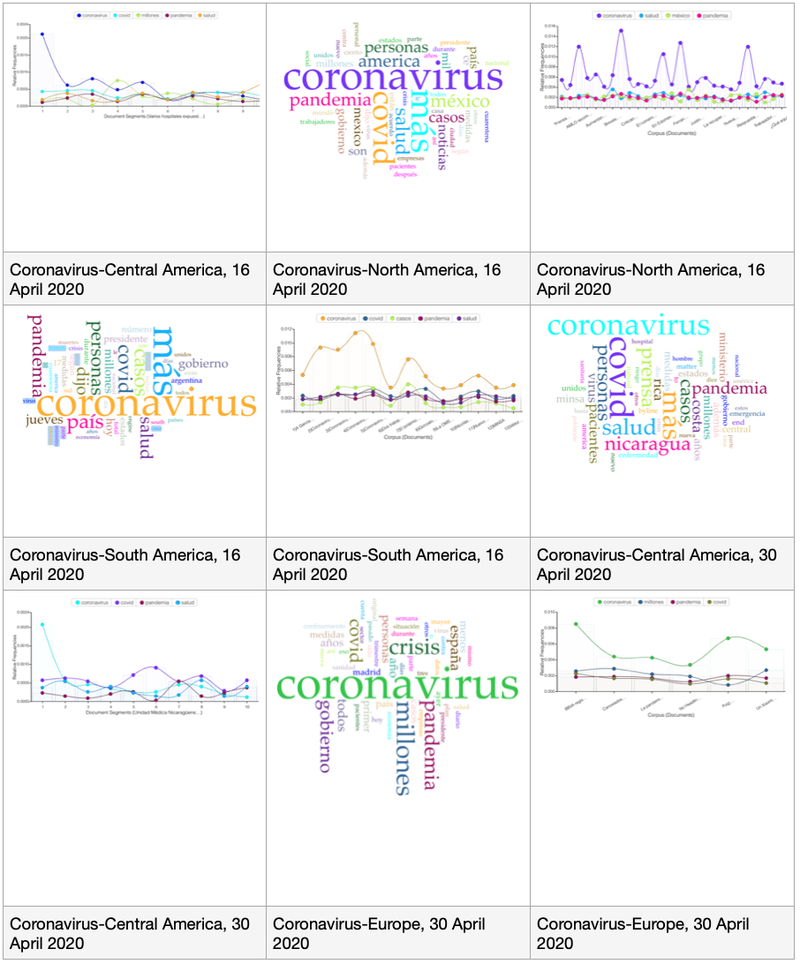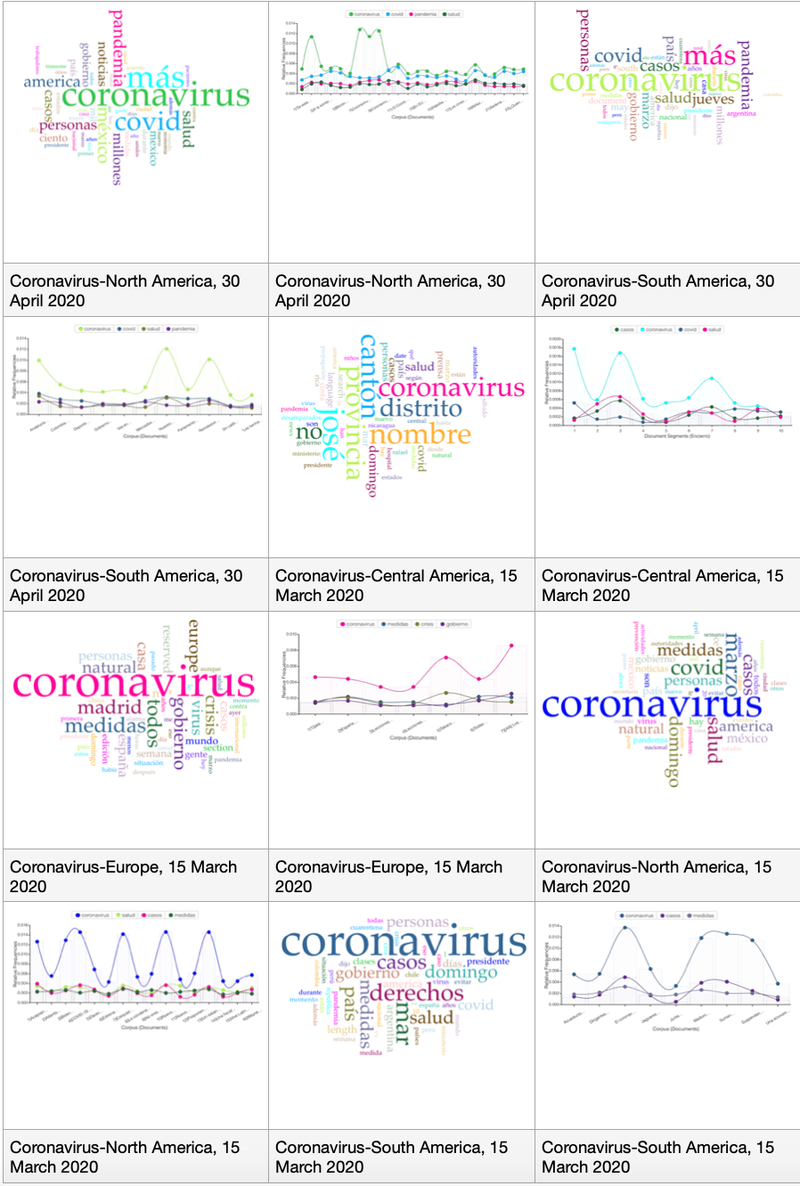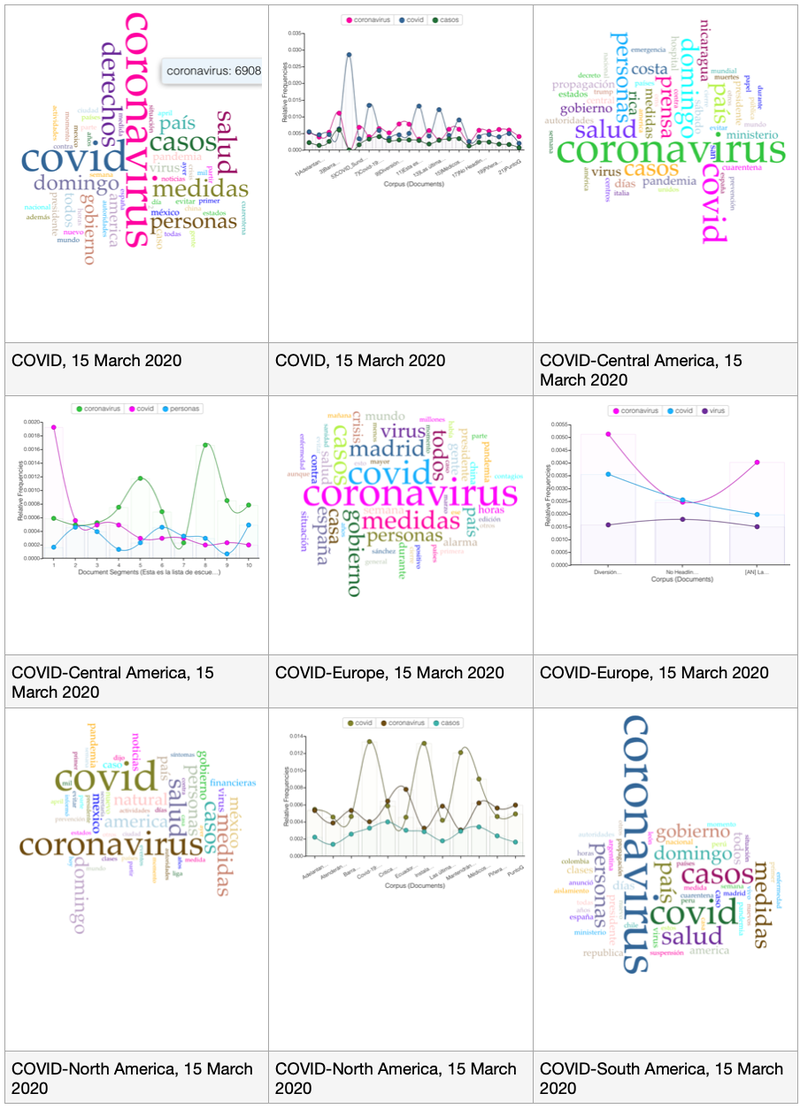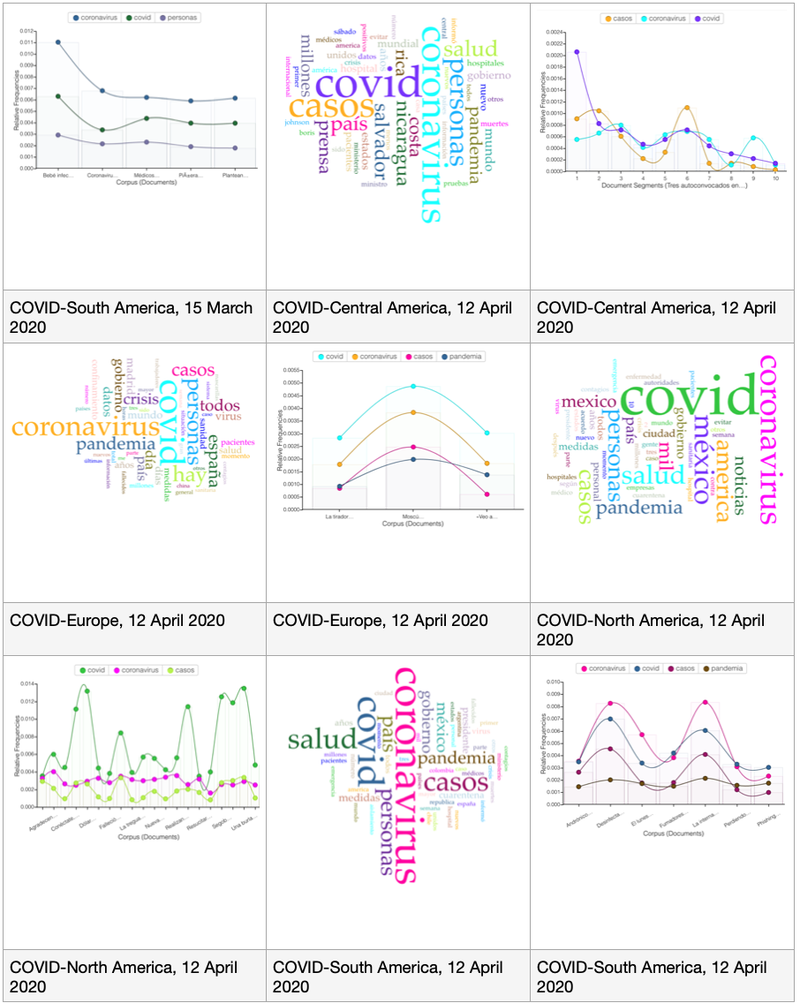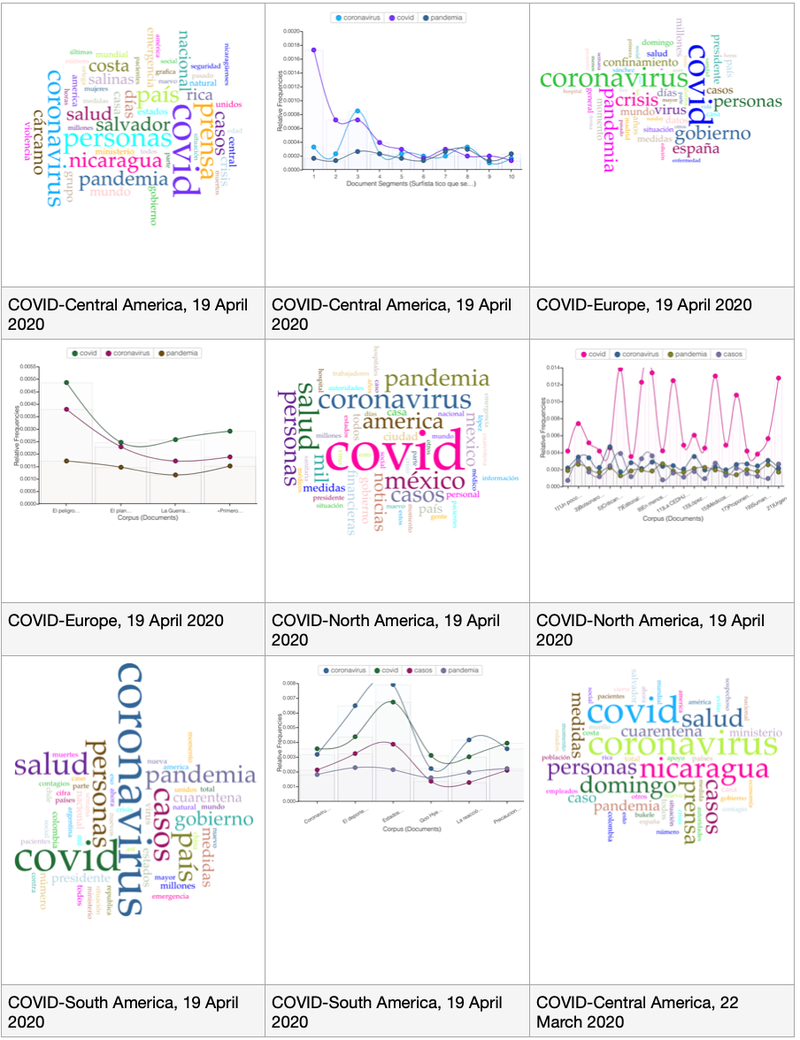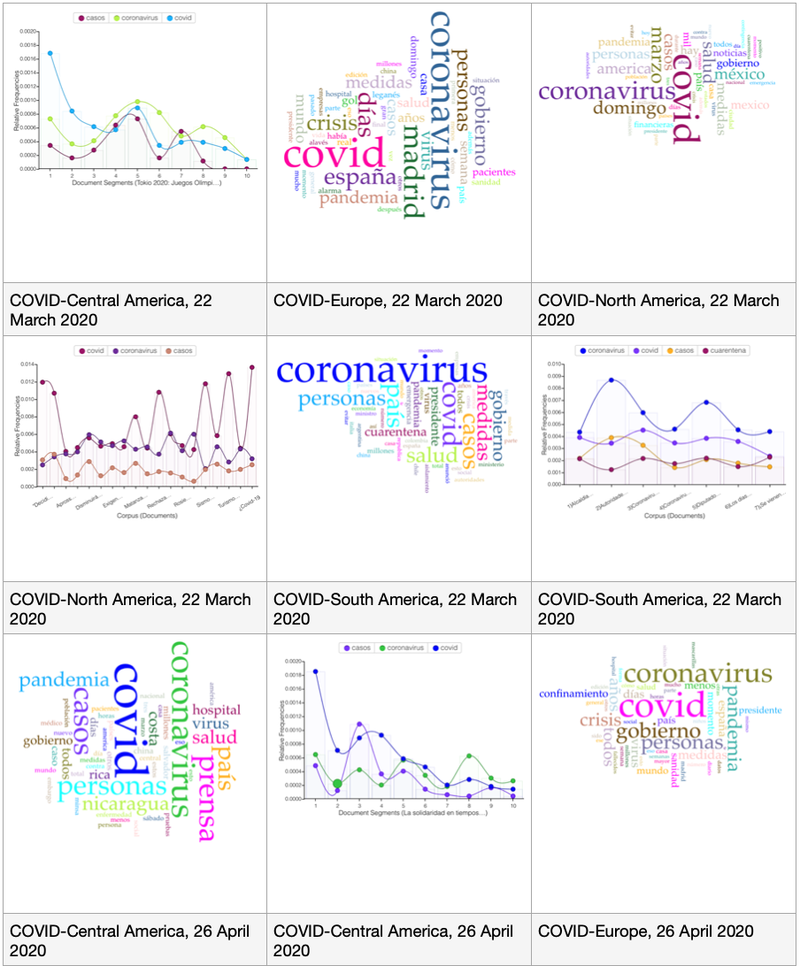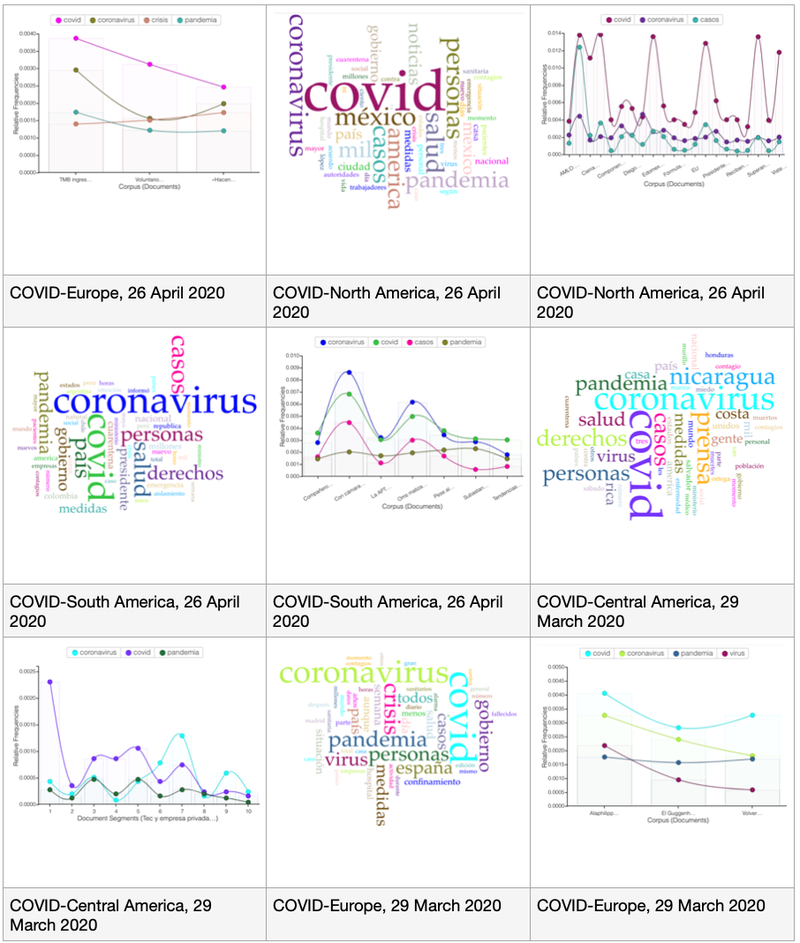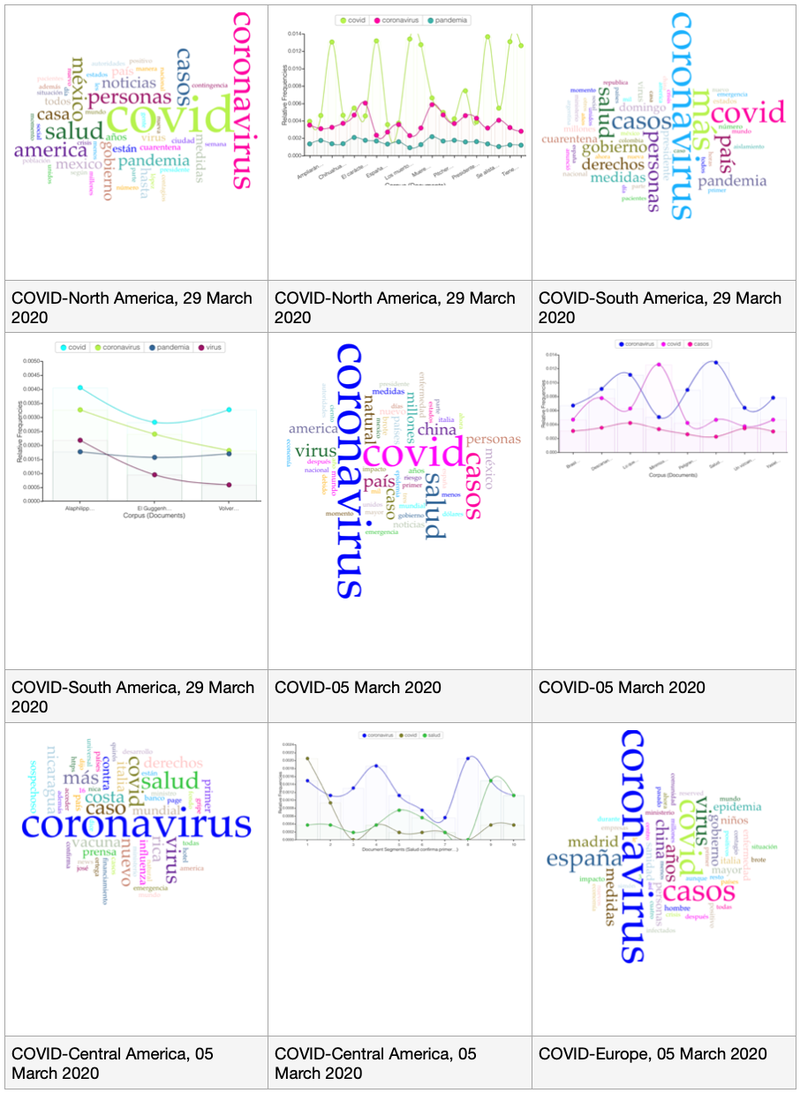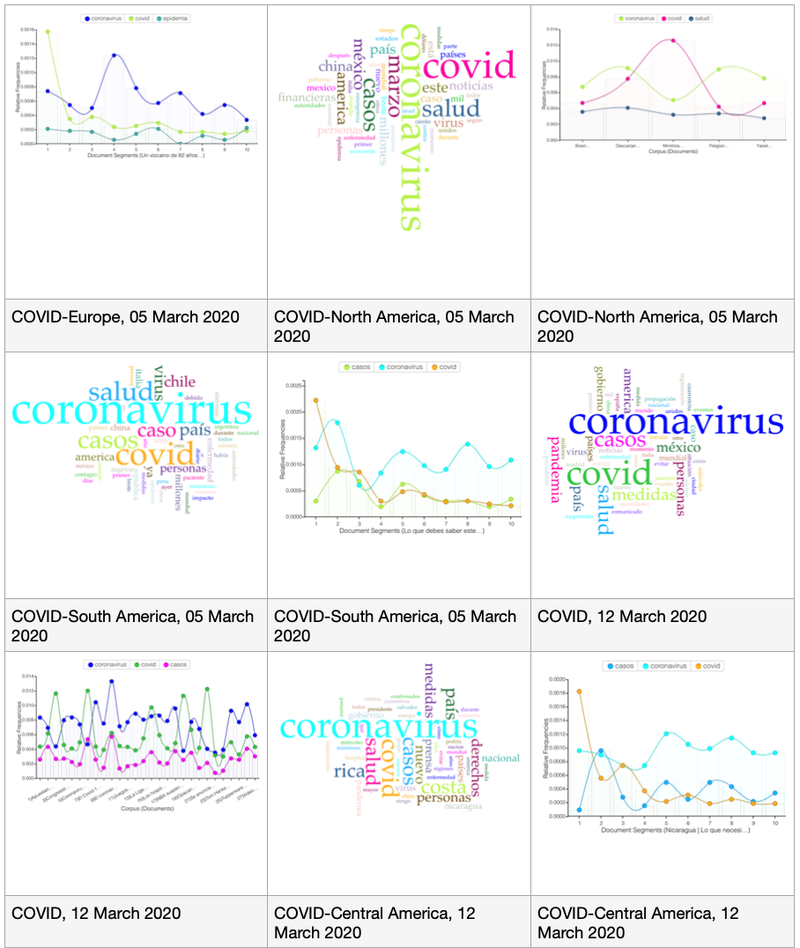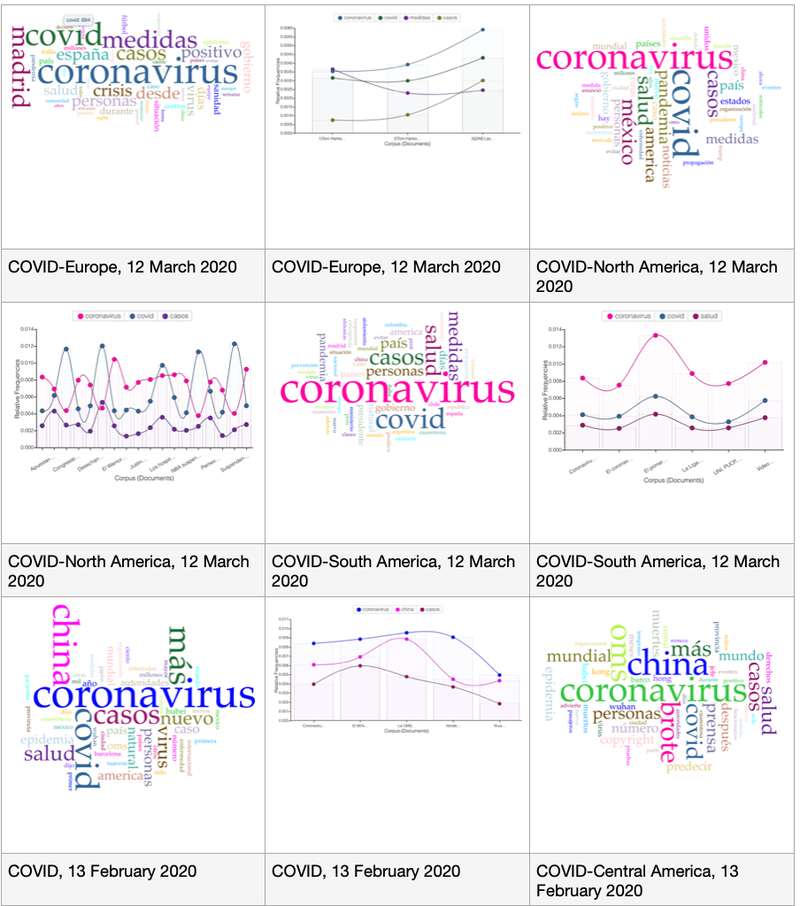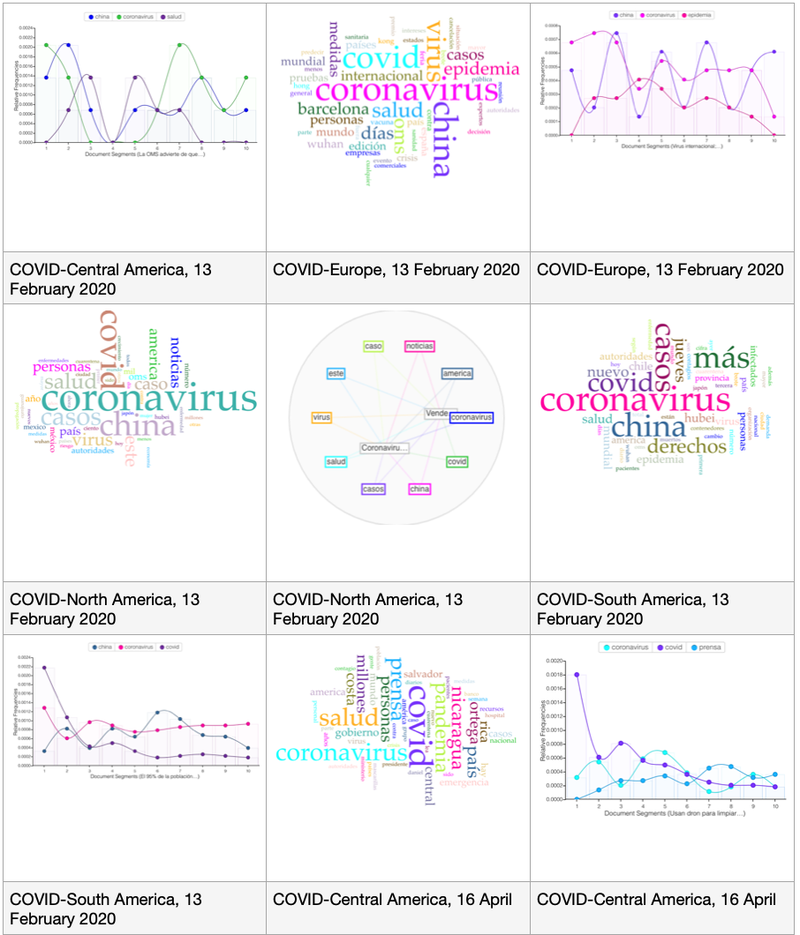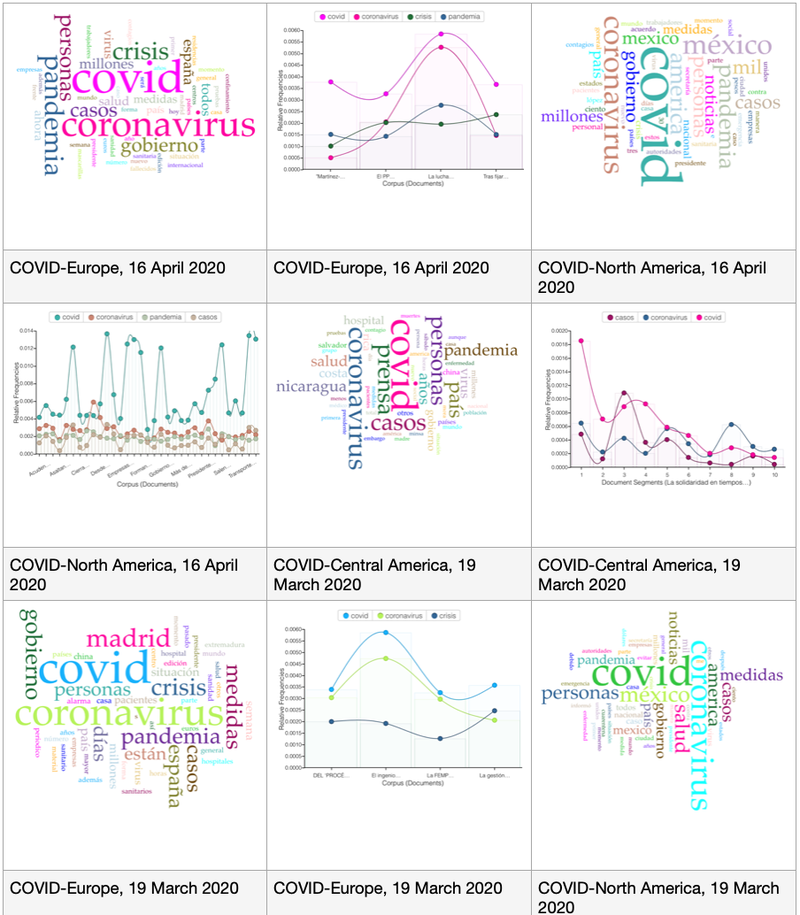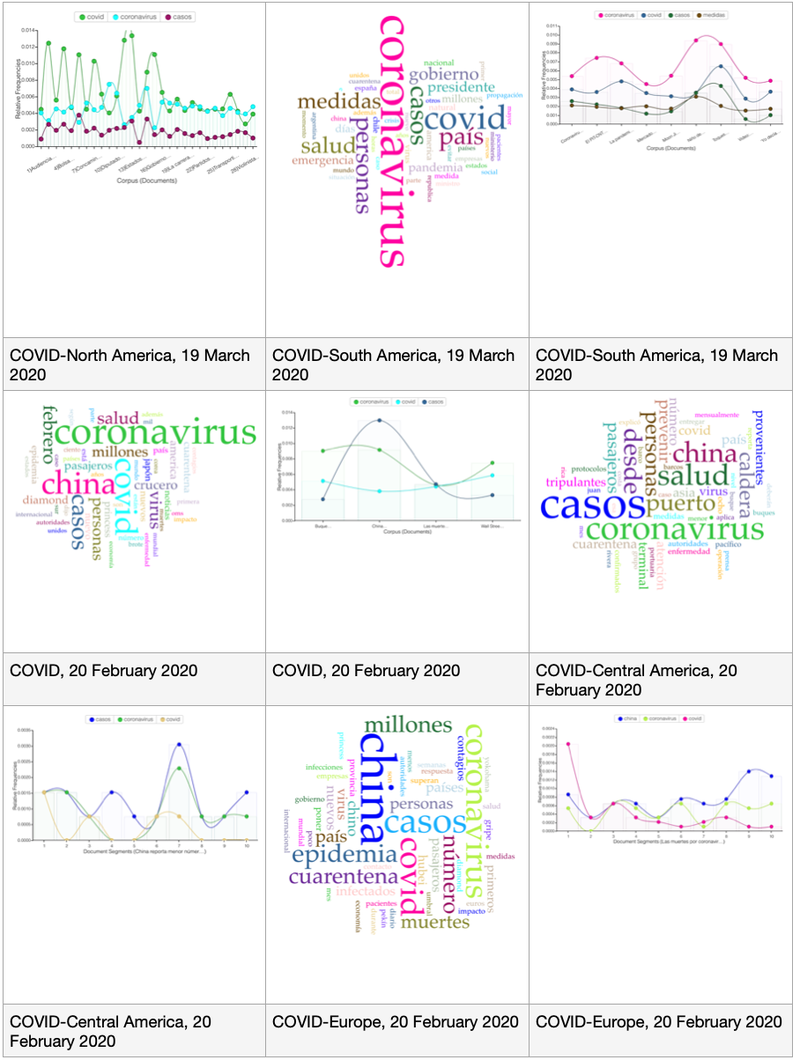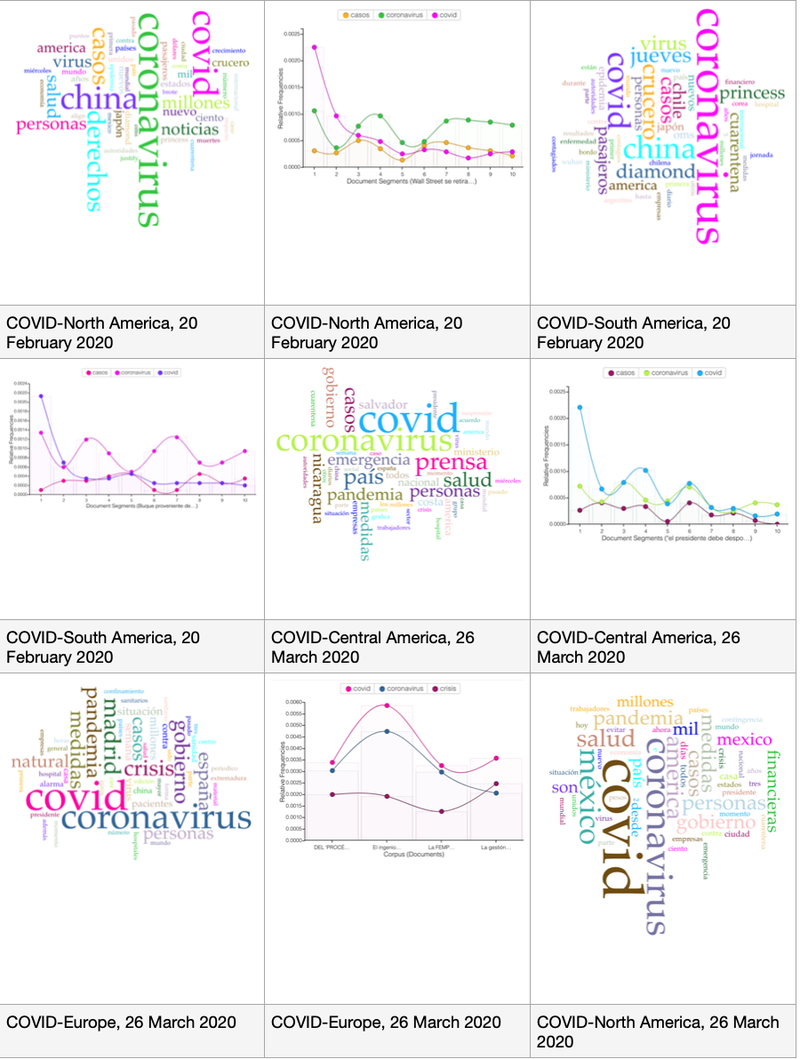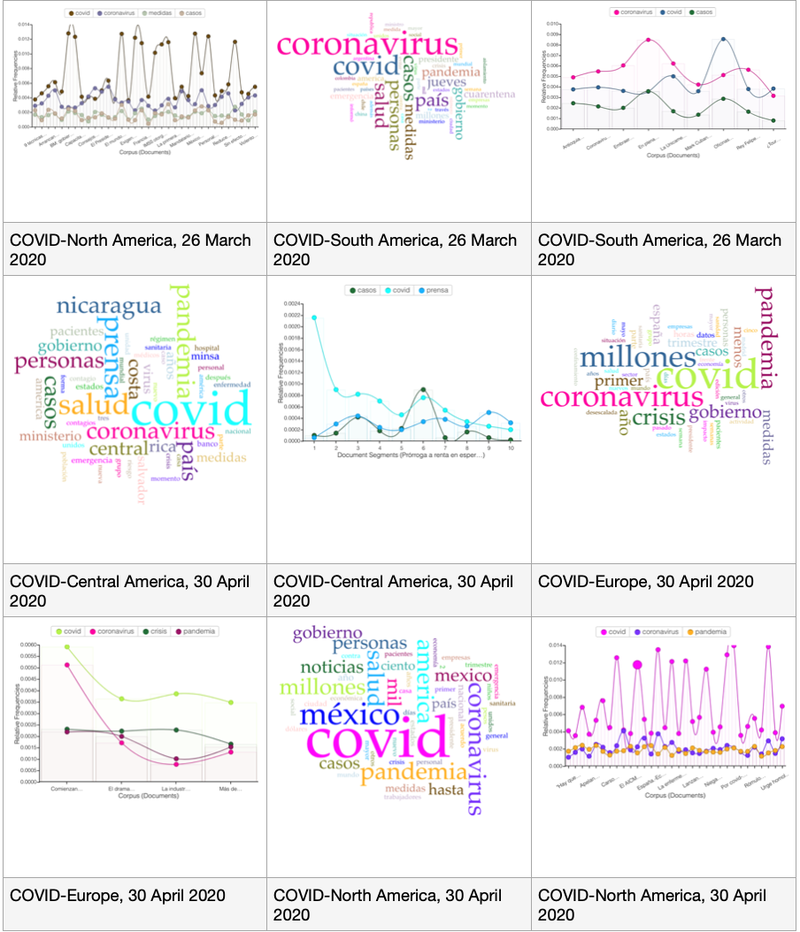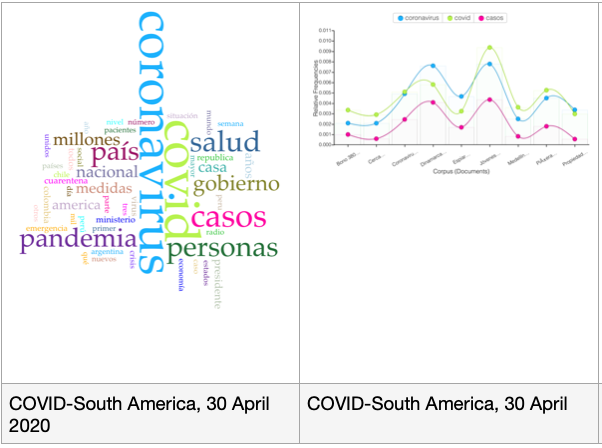Student ambassadors: Juan Albornoz Rodríguez | Louise Curtin | Holly Henry | Natalia Stengel Peña
Coronavirus
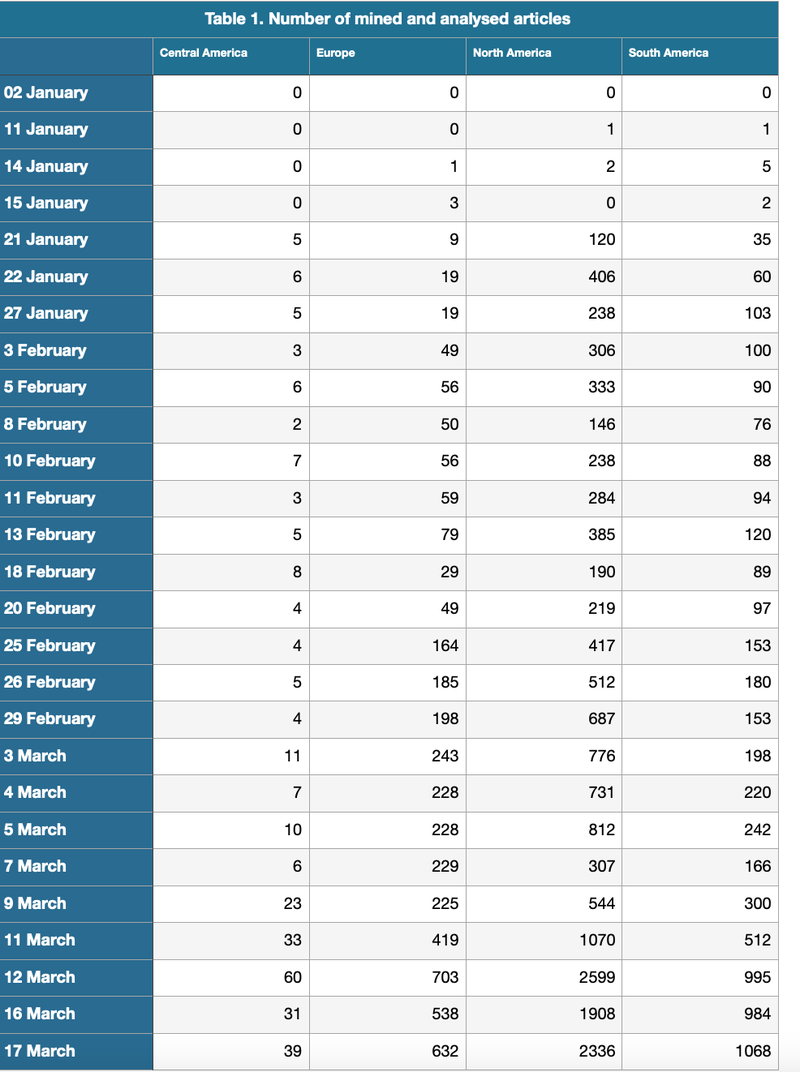
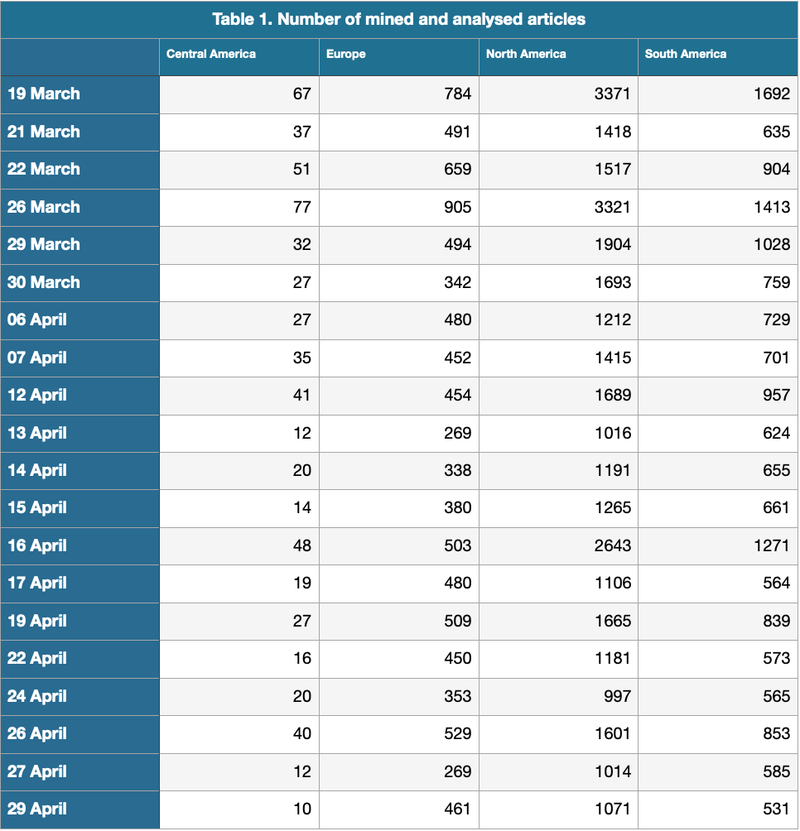
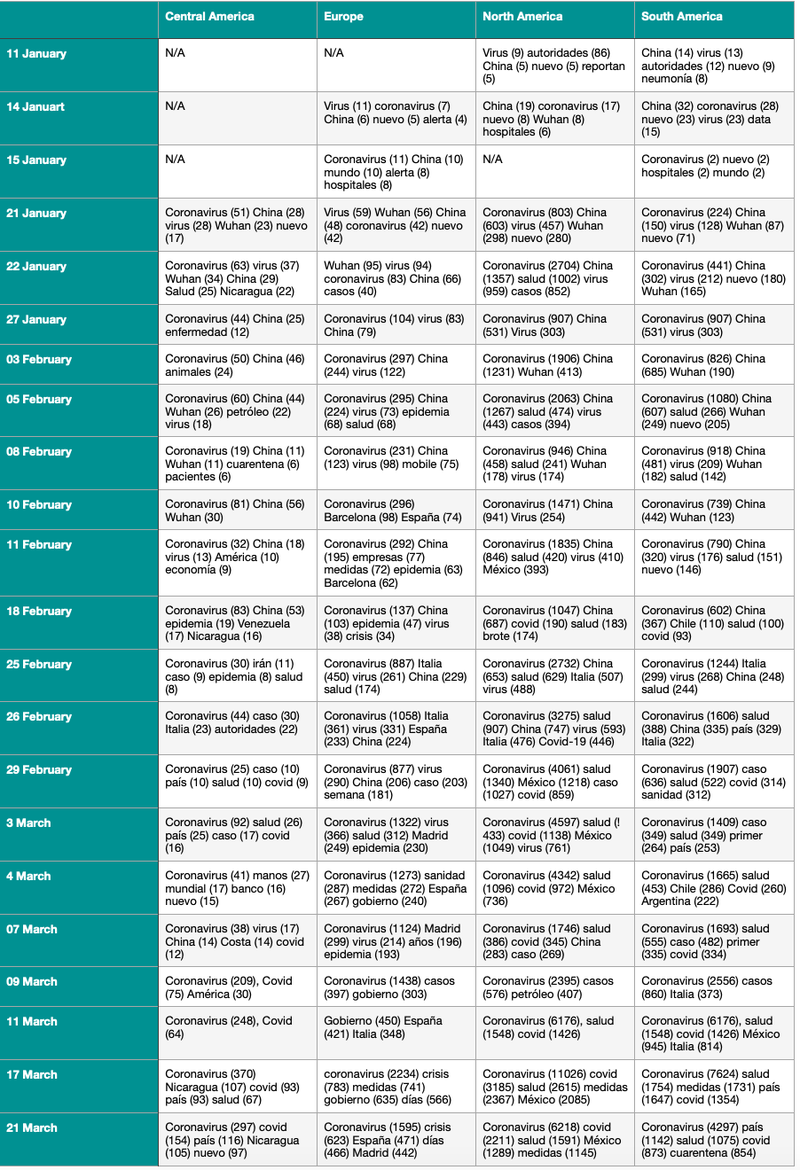
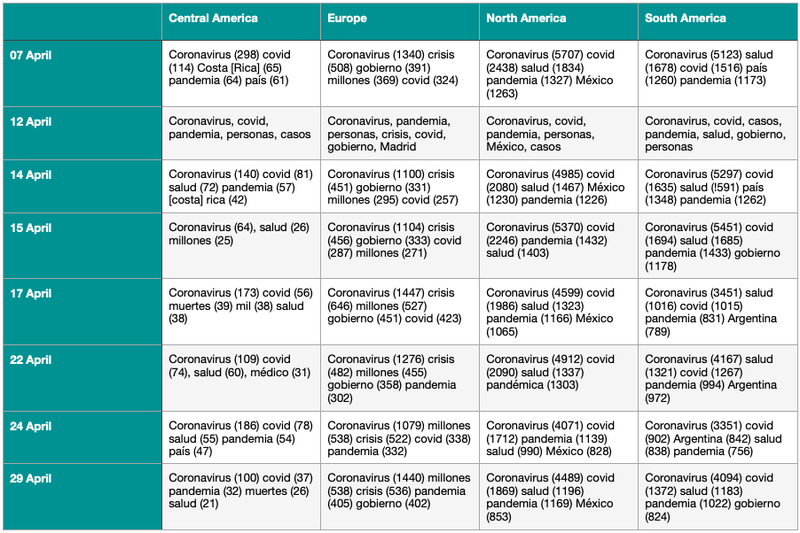
11 January: The frequency of the term reportar is related to the Chinese authorities’ report of the first Coronavirus fatality. In South America, they refer to the misteriosa neumonía mortal in China.
14 January: In Europe, North and South America, the phenomenon is associated with China and Wuhan.
15 January: there is not much awareness about the virus, and the narration focuses on what was happening in China.
21 January: In Central America, the word is linked to SARS. There is still relatively little knowledge of the virus. In Europe, there are concerns about whether the virus will reach Europe, what is called el virus de Wuhan. In North America, there are concerns about the virus’ effects on the debilidad en Wall Street. In South America, there are reports of the first case arriving in the USA.
22 January: In Central America, Coronavirus is portrayed as a Chinese problem. The ratio of coronavirus and China in North America is 2:1.
27 January: the context surrounding the word virus shows that the word is being used to compare it with SARS and the Swine Flu.
3 February: North and South America narrate what is happening in Wuhan. Central America explores the wild animal markets. There are a lot of concerns about the effects Coronavirus will have on the mercado.
5 February: In Central America, the virus is located in China, and the narration is related to that country; there are reports of corporations worrying about the mercado de petróleo. In Europe, the virus is out of Wuhan and spread to China; hence, it is seen as a possible global risk. In North America, there is an expectancy of what the Organización Mundial de la Salud says about the new virus. In South America, nuevo is a frequent term as they report about the nuevo coronavirus.
8 February: Reports from Central America are very few. In Europe, the death of Doctor Li Wending, the doctor in Wuhan who first raised the alarm about Coronavirus; the International Mobile Conference was cancelled in Barcelona due to Coronavirus raising some concerns about what the virus implies. In North America, the news focuses on the increasing death toll in China as well as the death of the first foreigner in China. Finally, in South America, there is a sense that the world is on alert as the death toll approaches four figures in China.
10 February: Europe stops referring to China as the first case to appear in Barcelona. South Americans are waiting for help to leave Wuhan.
11 February: In Central America, reports reveal that the virus has been officially named Covid-19; there is an increase in the frequency of terms such as economía, suggesting preoccupation. In Europe, epidemia is a frequent term as there is awareness on the continent of the global nature of the expansion of the virus. In North America, salud is a frequent word, suggesting there might be a health concern instead of an economic one. In South America, there is a strong correlation between coronavirus and aumentan as cases increased.
13 February: In Central America, reports state there is no need to worry about Coronavirus as the WHO stated it is too soon. In Europe, there are reports of a technology fair in Barcelona that was cancelled due to fear of Coronavirus. In North America, there are reports of the Coronavirus' effects on European markets. In South America, there are reports of the fallen down of prices of oil and copper.
18 February: In Europe, the word pasajeros is frequent as they report about infected passengers on the Diamond Princess cruise ships. In North America, the verb aumentar is found in several contexts around brote. In South America, they are discussing the origins of the virus.
20 February: In Central America, there are concerns about Coronavirus affecting the economy. In Europe, there is a quarantine for people recently travelling to China. In North America, there are concerns about the prices of oil. In South America, there are reports of people in Ukraine having to quarantine after visiting China.
25 February: In Central America, reports highlight single cases in Europe (the first confirmed cases in Switzerland and Sicily). In Europe, there are concerns about the increase of cases in Italy. In North America, China is frequent as they still mention coronavirus de China. South America has similar results to Europe, with concerns about the situation in Italy.
26 February: In Central America, Italia has gained a lot of attention as it is the first western country to experience cases of Covid. In Europe, Italia and España are more frequent than the term China. In North America, the term Covid is not one of the most frequent words, unlike in other regions. South America shares with the previous region a concern about salud.
29 February: in Central America, the first case in Ecuador is reported as well as the first death in the US. In Europe, there is fear of a recession and reports about businesses struggling due to the pandemic. In North America, cubrebocas is a frequent term related to the preventive measures to avoid the spread of the virus; a lot of the language refers to lockdown measures and sana distancia. In South America, the word sanidad is frequent concerning the various communications by health ministers.
3 March: In Central America, the term país is frequent as they report outbreaks in different regions and countries (neither China nor Italy are mentioned). In Europe, the attention is on Madrid. In North America, there are 21 suspected cases in Mexico. In South America, primer is a frequent word as they detected the primeros casos in Chile and Argentina.
5 March: In Central America, there are concerns about Easter celebrations during COVID. In Europe, Spain is discussing the possibility of closing institutions and some reports the government fears the economic impact of declaring a lockdown. In North America, while the USA’s cases are increasing, Mexico has no cases, and there are more economic concerns than health ones. In South America, Chile, Argentina, Brazil and Uruguay report the first cases of Coronavirus.
7 March: El Salvador call a yellow alert (alerta amarilla) as the first death of Coronavirus is registered in Argentina. In Europe, the word años is frequent as it refers to the ages of various individuals, mostly the elderly, who have died. In North America, the word caso is frequent as they report the first cases in South America. In South America, there is a similar tendency as in North America.
4 March: In Central America, lavarse las manos or desinfectante de manos are frequent as it is a promoted measure to stop the spread of the virus. In Europe, gobierno is a frequent word highlighting the virus's political pressures. In North America, the term Covid is frequent, along with a medical explanation of the virus. In South America, Chile and Argentina are hit for the first time. Surrounding the virus's arrival, frequent terms are sospechoso, aisladas, abandonar, apenas se enteraron de que; there is fear about the arrival of the pandemic.
9 March: China is not the primary concern, local cases and Italy are now the focus. The desplome de los precios del petróleo is also a concern.
11 March: in Central America, salud is three times as frequent as gobierno. In North America, millones is used 586, the vast majority of times talking about money. In South America, pandemia appears 808 as the WHO declares Coronavirus is a pandemic.
12 March: In Central America, all countries declared lockdowns except for Nicaragua. In Europe, Angela Merkel’s speech is highly commented on; there are reports about the WHO declaring Coronavirus a pandemic. In North America, the main concerns around the pandemic are economic, mainly because NAFTA has been signed between Mexico, Canada and the USA. In South America, all reports describe the extreme surveillance over citizens in Argentina.
15 March: In Central America, plenty of reports are concerned about the lack of Coronavirus measures in Nicaragua; news praise doctors and nurses for their work. In Europe, Coronavirus is described as a global threat. In North America, there are suggestions about the measures needed to avoid spreading the virus. In South America, there are reports on the war against Coronavirus.
16 March: the words batalla, combatir, enfrentar and guerra are more frequent, mostly when referencing political speeches.
17 March: In Central America, Nicaragua is a frequent term, from news about Miss Nicaragua to how it is the only Central American country not to have adopted drastic measures to reduce travel across its borders. In Europe, as the pandemic advances, there is more discussion of the measures required to contain the disease. In North America, there are reports on outbreaks of the disease in Mexico and how an economic downturn in the USA may impact the country. In South America, there are plenty reports on medidas extremas de aislamiento.
21 March: In Central America, Nicaragua is frequently mentioned as there are concerns about how they are handling the pandemic as the second case of Coronavirus appears. In Europe, Madrid is the epicentre of the pandemic; the advancement of the virus can now be felt on a day-to-day level; hence, the frequency of días. In North America, the focus is on medidas to prevent the spread of the virus as there are more cases; meanwhile, the economic discussion becomes less relevant. In South America, the word cuarentena is frequent as Bolivia and Colombia call for an obligatory quarantine.
22 March: Central American leaders recognised a crisis. In Europe, there are reports comparing Coronavirus with the Spanish flu and Ebola; some news reports true stories of people affected by the disease. In North America, while cases increase in the USA, the government's declarations are questioned. In South America, there are concerns about the economic crisis and how Coronavirus has affected (they used the word infectado) employment.
26 March: In Central America, they discuss preventing measures to avoid the spread of the virus. In Europe, the term medidas is trending; however, this time, it refers to measures to save the school system and the industries, unlike previously when discussing the measures to avoid the spread of Coronavirus. In North America, there are reports of discrimination and racism increasing. In South America, there are worries as the financial debt increases while in lockdown.
29 March: In Central America, there are reports of empty cities as lockdowns are declared. In Europe, news reports show relaxation as the infection rates decrease. In North America, the number of Coronavirus cases duplicated from one week to the next. In South America, there are reports of the German Minister of Economy who committed suicide.
30 March: words like cuarentena and aislamiento are frequent.
6 April: In North America, the attention is on describing what is happening in New York. Like in Europe, guerra is a common term. The word ayuda is frequent as countries are asking for or need help.
7 April: In Central America, most news refers to the disease outbreak in Costa Rica. In Europe, it is estimated that the impact of the pandemic on the tourism industry in Spain will lead to a loss of 55 million euros. In North America, Mexico’s president is criticised for providing economic support to small businesses only; his plans are described as insufficient and incomplete, given that 1 million jobs are at risk. In South America, unlike in other regions, pandemia is a frequent term.
12 April: In Central America, coronavirus changes social relations and discrimination against some social groups. In Europe, there are reports discussing online education as the lockdown alternative. In North America, the economy is a major concern; meanwhile, there is a suspicion that Mexico is reporting cases of Coronavirus as atypical pneumonia. In South America, while the economies are clashing, there are not enough mechanic ventilators available in the world.
13 April: In Europe, the focus is on health and government issues. South America and Central America concentrate on reporting the numbers of dead and infected people.
14 April: In Central America, Costa Rica is the focus. In Europe, the term gobierno is common as the government announces a loan to pay for pensions. In North America, Texan authorities are asked to avoid non-essential journeys to Mexico; there is further criticism of Obrador's policies in Mexico.
15 April: In Central America, the use of millones refers to the millions of cases and dollars as they recognise a health and economic crisis. In Europe, crisis is related to panic and chaos. North America is the Spanish region in which covid is more commonly used. In South America, cuarentena is often used as countries call for a lockdown.
16 April: In Central America, there are reports of the first deaths due to Coronavirus. In Europe, there are reports of Trump cutting funds to the WHO. In North America, there are reports of how the relations between Mexico and the USA might increase cases of Coronavirus; doctors in Mexico do not have medical equipment. In South America, there are reports about the strict measures in Argentina.
17 April: In Central America, the reported muertes are from Wuhan, Guayas, the United States and Italy. In Europe, the pandemic is widely reported in economic terms. In North America, there are concerns about how much the pandemic is affecting the tequila companies. In South America, there are reports indicating doctors how to dress for safety as 14% of the casos sospechosos are medics.
19 April: In Central America, medical personnel are discriminated against and attacked. In Europe, Spain reports more than 20,000 deaths due to Coronavirus. In North America, in Mexico, there is not enough medical equipment to confront Coronavirus; meanwhile, the USA has more cases, yet they reopen beaches in Florida. In South America, Argentina is very strict with lockdown measures; on the other hand, Brazil’s president has been criticised for not respecting the lockdown.
22 April: In Central America, Covid is a frequent term; meanwhile, the medical implications of the virus are the main subjects; hence the frequency of words like salud or médico. In Europe, the term crisis is used in a wide range of contexts: sanitaria, social, financiera, alimentaria or económica. In North America, there are two crisis, economic (empresas, trabajadores) and a health one (hospital, enfermedad). In South America, Argentina is the epicentre of the pandemic as Chile and Peru were.
24 April: In Central America, reports focus on the effects of the disease on various countries worldwide and the possibility of a world hunger crisis. In Europe, millones are frequent as they discuss the economic impacts of the pandemic. In North America, Mexico is still in the spotlight as cases increase and the Mexican diaspora struggles in the US.
26 April: In Central America, there are several reports of how much Coronavirus affects Ecuador, where bodies are piling up, and there are no medical conditions or funeral homes. In Europe, there are concerns about having to work and not being able to keep the two meters distance. In North America, Trump's administration is divided; some support lockdowns and others want to finish them. In South America, Argentina's lockdown is still commented on as it is more strict than other South American countries.
27 April: There is a detailed description of what some countries are doing to stop the spread of the virus.
29 April: In Central America, pandemia and crisis are frequent as there is a notion of panic in the media. In Europe, there is a preoccupation with the economic and political effects of the virus; hence, the terms millones and gobierno. In North America, the health and financial crises are frequently discussed.
30 April: In Central America, Costa Rica is recognised as a responsible country as it promotes a solid health system. In Europe, there are reports about the consequences of Coronavirus; they seem to believe the worst is over. In North America, there are concerns about the conditions in which essential workers work. In South America, there are reports of the problems inmates are facing in prisons.
Covid-19
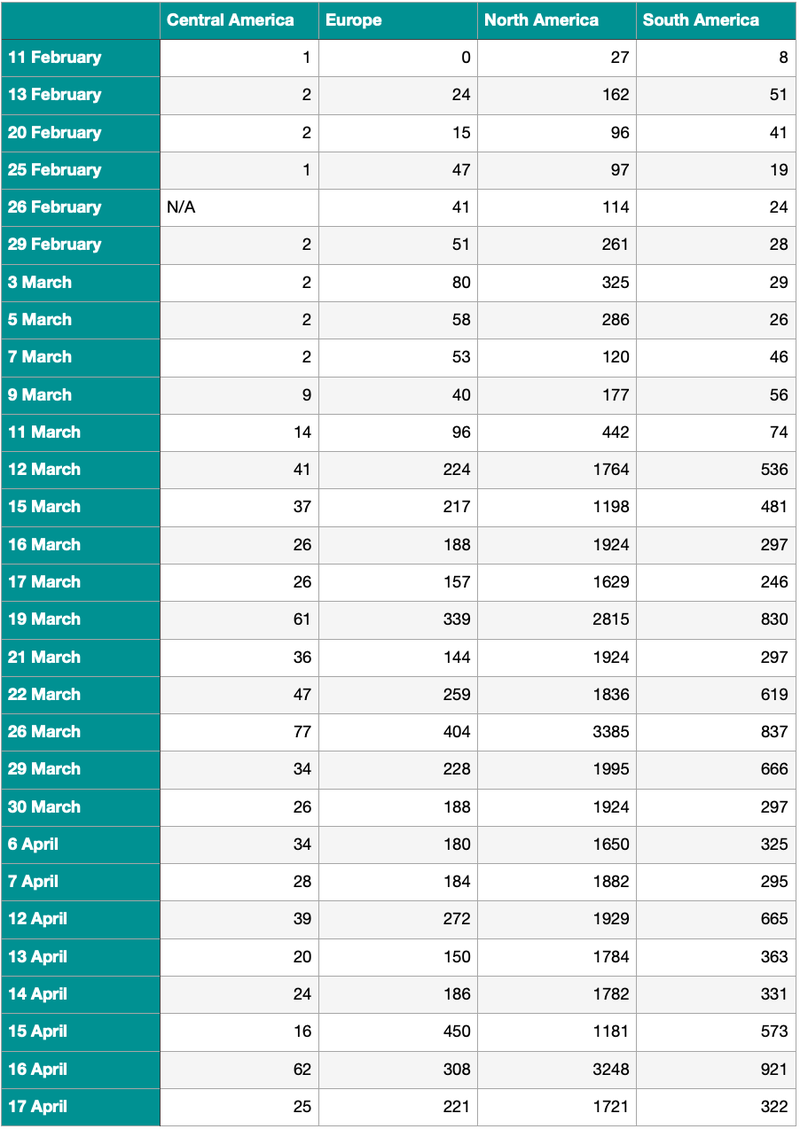
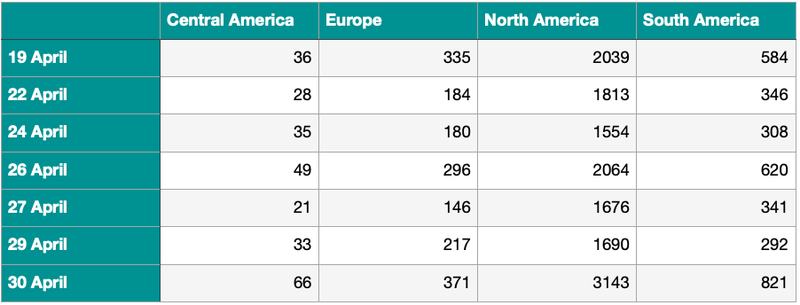
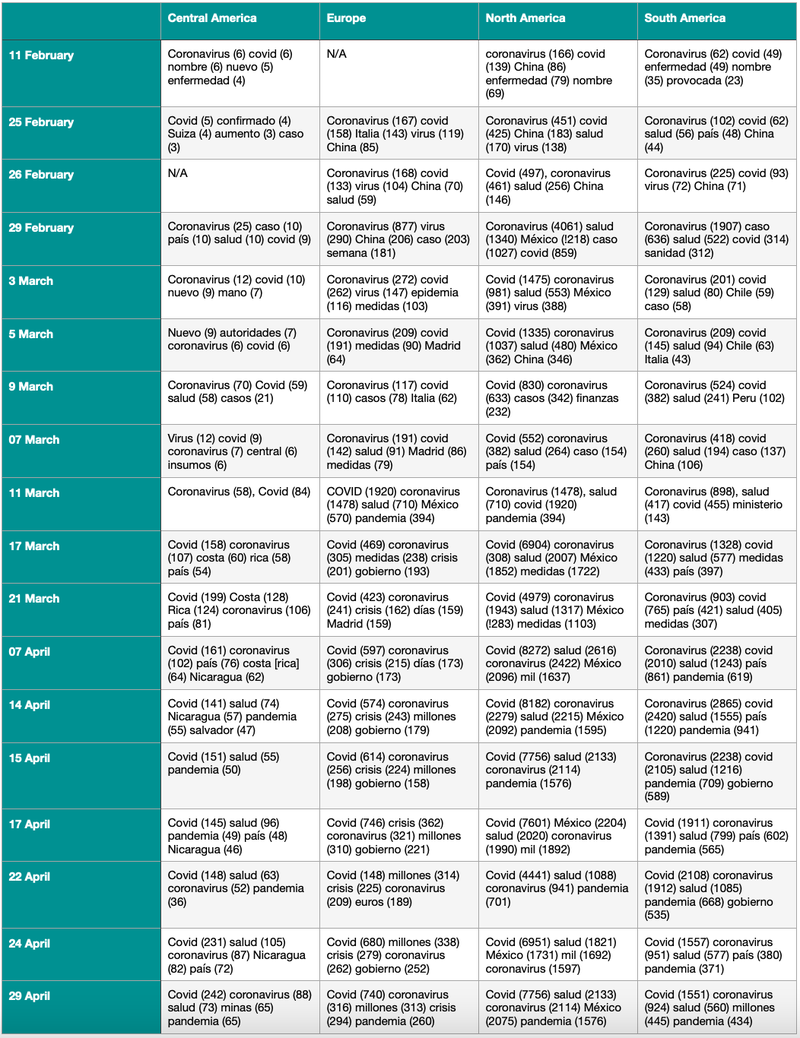
11 February: In Central America, the only report refers to the recently named Covid-19. In North America, the virus is still associated with China. In South America, provocada is a frequent term as they explain the virus that provocó la pandemia has been named.
13 February: In Central America, COVID-19 is described as unpredictable as it remains in China. In Europe, there are descriptions of COVID-19 in China and its social and economic effects. In North America, newspapers reported that the WHO named the new disease COVID-19. In South America, there are suspicions China is hiding the actual number of cases of COVID-19.
20 February: In Central America, there are concerns about eight touristic ships arriving from Asia. In Europe, they wonder how COVID-19 will affect the population living in poverty. In South America, they report the Diamond Cruise stock in Japan due to COVID-19 cases.
25 February: In Central America, the only report is about the first case in Switzerland. In Europe, Italy is frequent as there are more cases and the number of muertos increases. In North America, China remains a highly frequent keyword, although Italy is also prominent. In South America, there is an economic focus; the pandemic is referred to as el Coronavirus Chino Covid-19.
26 February: In Europe, they used, not very frequently, the expression Coronavirus chino to describe what is Covid-19. Coronavirus is more frequent than Covid.
29 February: In Central America, although Covid is unfrequent, there are articles reporting infection rates and the death toll in China. In Europe, the word países is linked to the risk of global expansion; however, there is no presence of the word pandemia. In North America, Covid is more frequent than coronavirus, and it is related to salud, primarily the health of authorities, medical professionals and health precautions. In South America, the news is similar to the ones in North America; the first cases in Mexico are reported.
3 March: In Central America, authorities advise not to shake hands at gatherings. In Europe, they stopped focusing on China and Italy; there are concerns about the epidemia and the medidas needed to avoid spreading the virus. In North America, Covid is more frequent than Coronavirus. In South America, Chile confirms the first case of Coronavirus.
5 March: In Europe, banco and economía are frequent terms as they are related to the economic crisis. In North America, salud is a common word associated with Covid. In South America, Chile and Italia are the epicentres of the pandemic.
7 March: In Central America, insumos is frequent as Costa Rica got seven truckloads of hospital instruments. In Europe, Madrid focuses on reporting as cases and deaths increase. In North America, news reports on the recent outbreaks. In South America, the word síntomas is frequent, unlike in other regions.
9 March: North American news is related to finanzas; meanwhile, South and Central America to health issues.
11 March: In Central America, COVID is associated with terms like enfermos, mortalidad and contagio. In Europe, the narration describes Spain, the second country with more cases in the region. In North America, the term pandemia is frequent as WHO declared COVID a pandemic. In South America, Peru is the first country to use the word COVID.
12 March: In Central America, there are reports about the lack of clean water and how important this resource is during COVID-19. In Europe, COVID-19 is described as a global problem. In North America, Trump closed all the borders of the USA and suspended any flight coming or going to Europe. In South America, there are rumours, started by Maduro in Venezuela, about having a cure for COVID-19, a pill developed in Cuba.
15 March: In Central America, there are reports on how doctors and nurses are experiencing discrimination; others discuss how bad COVID is in the USA. In Europe, there are reports about how unhealthy it is for people to be reading about COVID all day long while in lockdown. In North America, there are reports of how Mexico did not cancel the music festival ViveLatino. In South America, there is a description of the strategies needed to fight COVID-19 inspired by warlike vocabulary; meanwhile, they use the metaphor of the economy being in intensive care.
16 March: In North America and Europe, unlike South and Central America, the word guerra is common; however, in the first region, it is related to facing the virus and in Europe, to memories of the Second World War.
17 March: In Central America, Costa Rica remains prominent due to its rising number of cases. In Europe, the word gobierno refers to the Spanish government’s approval of financial support of 100 million Euros to small businesses due to Covid-19; the term crisis sanitaria is frequent. In North America, medidas refers to the financial aid announced by the government and preventative hygienic measures/advice. In South America, emergencia is prominent.
19 March: In Central America, there are reports about Nicaragua hiding cases of COVID-19. In Europe, COVID-19 is described as alarmante (alarming) as the economy and the measures to confront COVID-19 were not ready. In North America, a news report claims they are experiencing the fall of the American Dream. In South America, the first deaths due to COVID-19 are confirmed.
21 March: in Central America, Costa Rica, and Nicaragua, authorities convene an emergency meeting regarding Covid-19. In Europe, the virus kills 10 Spaniards every hour. In North America, Mexicans pressure AMLO to increase the health precautions and adopt the same level of measures as other countries; hence, the frequency of medidas. In South America, there are reports of new cases and quarantine measures in Bogota; in Chile, mayors are demanding that Piñera imposes a national quarantine.
22 March: In Central America, reports are about sports events being cancelled due to COVID; there are also explanations about how the food production industry is changing. In Europe, the number of cases is rapidly increasing in Spain. In North America, Mexico started to close public places like cinemas and museums. In South America, there are reports about what is happening in Italy with COVID.
26 March: In Central America, there are reports on the strategies to prevent the spread of the virus; some news covers the declaration of the former Mexican actor, now deputy, Carmen Salinas, stating: es un castigo de Dios a los chinitos por comer perros (COVID-19 is God’s punishment to Chinese people for eating dogs). In Europe, there are reports of the Spanish government supporting the most vulnerable populations. In North America, Trump stated that the medicines for Lupus and Malaria could treat COVID and start chaos. In South America, countries discussed the impact of lockdowns while the state of emergency was extended in different countries.
29 March: In Central America, there are concerns about tourists not respecting the COVID rules and spreading the virus. In Europe, there are complaints about the health system and the Government’s responsibility. In North America, Mexico decentralised the COVID-19 tests for a while; they were only available in the capital. In South America, Peru changed its national emblem to ¡Quédate en casa! (Stay home!); there are several articles showing concerns for football players during the COVID pandemic.
30 March: cuarentena is a frequent word as narration explores the scientific aspects, economic consequences, cultural effects and explanations of how to proceed with lockdowns.
6 April: North America is the region where covid is more frequent. In South America, there are descriptions of what life is in cuarentena.
7 April: In Central America, Costa Rica is the epicentre, while in some, there are some reports of the infringements of lockdown measures. In Europe, días refers to the duration of quarantine measures. In North America, mil refers to the high death toll; the majority of stories are health-related; there is also coverage of a 90% reduction in car sales, which is expected to affect annual sales by $110 mil millones. In South America, pandemia is a frequent term, accompanied by words such as: se inicio, se avanza, enfrentar, riesgo and difíciles.
12 April: In Central America, there are reports about the USA being the country with more cases. In Europe, there is suspicion that there will be COVID waves. In North America, there is fear the economy is not ready to deal with COVID. In South America, Peru declared an emergency state; Colombia disinfected streets; Bolivia described the crisis as a public calamity; and Argentina closed every border.
13 April: the narration is more general. All regions are reporting the numbers of statistics related to Covid.
14 April: In Central America, the scale of the health crisis is the focus of reporting with the word salud and pandemia. Nicaragua and El Salvador are mentioned concerning the World Bank’s prediction. In Europe, millones is a frequent term related to the economic impact on small businesses, which becomes evident as the lockdown continues. In North America, Mexico is frequently mentioned as it is exempted from Trump’s PPE export ban. In South America, there are reports documenting how communities are haciendo frente a/ante la pandemia, including Chile, Argentina and the Amazon.
15 April: In Central America, Costa Rica is the epicentre of the virus. In Europe, confinamiento (lockdown) is a popular term as people are confined to their houses and zones. In North America, crisis refers to an economic and political one. In South America, presidente is popular as news reported what Colombia’s president, Duque, is doing to respond to the virus.
16 April: In Central America, several news reports Daniel Ortega, Nicaragua’s president, as they believe he is lying about the number of cases. In Europe, European countries are discussing the return to normality with preventive measures to avoid a second wave of COVID-19. In North America, the USA is quickly reaching 30,000 deaths.
17 April: In Central America, Nicaragua is the spotlight. Europe has an economic focus as there are reports about banks and companies dealing with the pandemic. In North America, Mexico is the spotlight since it has a high death toll and poverty and hunger are alarming, so staying at home is more deadly for some Mexicans than going out. In South America, there are reports about losses suffered by various businesses.
19 April: In Central America, there was a need for the news to clear that the use of Hydrochloroquine (treatment for Malaria) is helpful against COVID, but it needs to be administered by professionals. In Europe, there are explanations of how poverty and exclusion make people more vulnerable to COVID. In North America, there is food lacking, resulting in people queueing outside supermarkets. In South America, there are concerns about how COVID represents a big problem for ‘small leaders’ cannot stand against.
22 April: In Europe, crisis is more common than in other Spanish speaking regions. In North America, covid appears four times more frequently than any other term, the language surrounding it is more scientific and less dramatic than the language surrounding the term coronavirus. In South America, Covid is more used than Coronavirus.
24 April: In Central America, salud remains a frequent term suggesting a health perspective. In Europe, the emphasis is still on the financial impact of Covid-19 (millones, euros, crisis and medidas). In North America, people in Mexico are thanking and supporting doctors #GraciasPersonalMédicoMx. In South America, Colombia is the spotlight reporting 5,000 infected cases.
26 April: In Central America, there are reports about China providing medical equipment to Central American countries and wonder about its reasons. In Europe, reports aim to prevent the same mistakes they had during the first lockdown due to the start of the second wave of COVID. In North America, Mexico, and the USA, it makes mandatory to wear cubrebocas (masks); on the other hand, there is fear about how ignorance about COVID-19 may affect vulnerable communities. In South America, COVID-19 is getting worst due to neglected social issues: miss-care of the elderly, people in poverty and communities settled in challenging to reach locations.
27 April: there is a prevalence of narrating what is happening in Europe and North America as if it was not a global issue.
29 April: In Central America, the Nicaraguan situation is followed closely. In Europe, preoccupation increases as crisis and pandemia are more frequent; therefore, terms like menos probabilidad, incertidumbre, consecuencias and repercusiones are frequent. In North America, Covid has become more frequent than Coronavirus. In South America, the narration privileges the political effects (gobierno appears 293) over the educational ones (escuela appears 21 times).
30 April: In Central America, there are reports about how UNICEF, UNESCO, the World Food Program and the World Bank agreed that students should return to school to avoid a catastrophic recoil on education. In Europe, Spain is worried about the effects of COVID-10 on the automobile and football industries. In North America, there is tension between the USA and Mexico as organised crime delivers goods to vulnerable populations in need. In South America, Uruguay’s Work Minister stated that the government would show solidarity with the workers who lost their jobs due to COVID.
Visualisations
